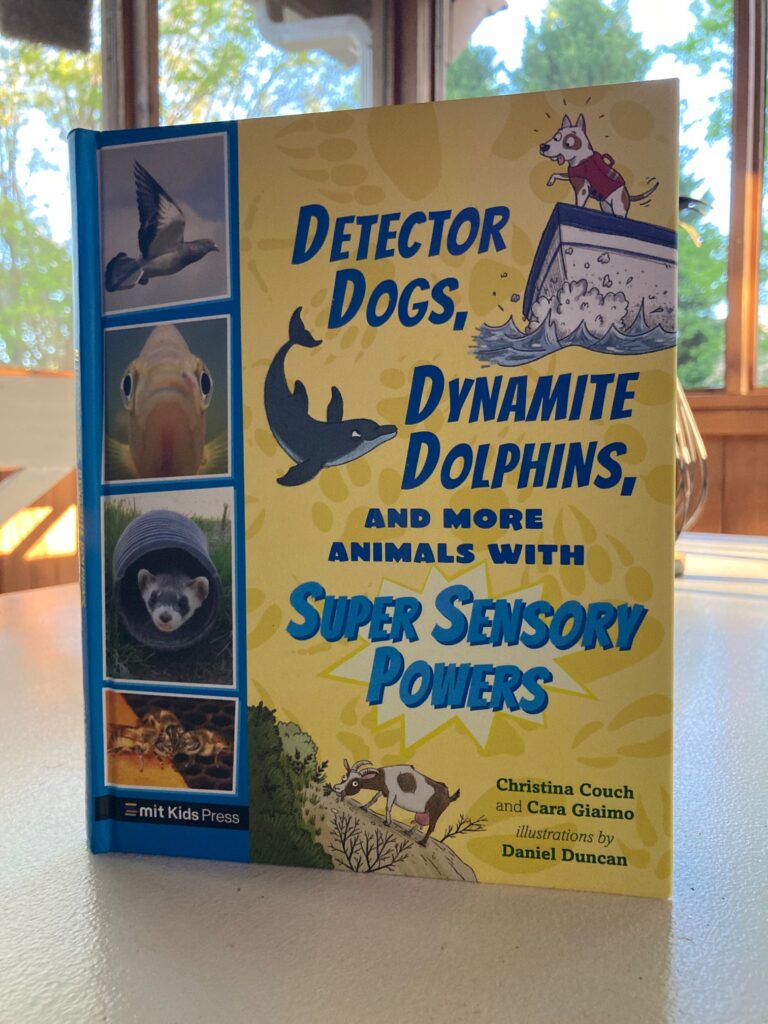The thing about getting kids to enjoy subjects that they otherwise might shun is effectively baiting the hook. Those students are attracted to the graphics, photographs or obvious sense of humor that the book has and then start thumbing through it. After a couple of pages they realize that it’s not the death trap of fun that they thought it would be, and start accepting the fact that reading can be fun. Detector Dogs, Dynamite Dolphins, and More with Super Sensory Powers wants to be that book and firmly plants the idea for that on its cover, but is it?

Detector Dogs, Dynamite Dolphins, and More Animals With Super Sensory Powers is incredibly high in STEM biological knowledge and facts. It’s also a book that has actual, physical weight behind it. It weighs more than you think a book of its size would be, but that’s due to the glossy pages and its cardboard covers. Its appearance and packaging make it a natural fit for those kids who are attracted to the Nat Geo Kids style of books…to an extent.
Let’s be clear, this is a great book that does an excellent job at doing a deeper dive into a topic that those nature or STEM kids will easily fall into. Detector Dogs is broken up into eight chapters that does a very comprehensive job at explaining to ages eight through 14 about trained dolphins, animal tracking, the communal aspects of bees and more.
For example, the chapter on Special Delivery Pigeons uses some great vocabulary like selective breeding, wayfinding, and a very thorough explanation of the Earth’s magnetic fields. Those more complex topics are granted a page of their own to fully explain the terms and are usually associated with a map, graphic or illustration to drive the point home. There are activities at the end of each chapter that provide kids the chance to do a craft or experiment that further illustrates the principal that benefitted the animal or animals highlighted in the chapter.
Those kids that are STEM curious will enjoy the deeper-than-usual nature that a book on this level provides them. The downside is that Detector Dogs is not as immediately intuitive as some other heavily illustrated animal or STEM books. Those other books will cast a wider net that won’t dig nearly as deep as Detector Dogs. This book is the deep end of the STEM animal pool. It’s looking at eight traits or skills that animals are capable of, and telling those fourth through seventh-graders all about them.
Kids that aren’t STEM curious or already want to read about science won’t be that attracted to Detector Dogs. The text and pictures in the book do an excellent job at teaching the habits and traits that make these animals so adept at being trained. It’s because the paragraphs are just a bit longer than those younger ages are used to, and the fact that there are indeed chapters dedicated to specific abilities. Some audiences have been, like the animals in the book, trained to expect blurbs or very short, simple paragraphs.
These paragraphs are very short and might only consist of five simple sentences about the STEM nature of their topic. That is more of a factoid presentation that’s aimed at younger to mid-elementary school students. Detector Dogs is aimed at those older ages in that spectrum that want to read about smart, trainable animals. The quandary of the book’s presentation is that the way it looks might be viewed as too simple or juvenile for middle school when in actuality, the content is spot-on for them.
There are affiliate links in this post.





 Facebook
Facebook Twitter
Twitter Flickr
Flickr GooglePlus
GooglePlus Youtube
Youtube